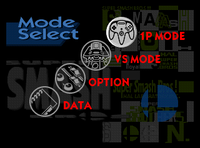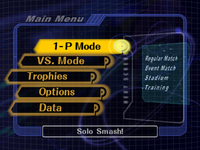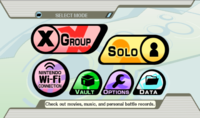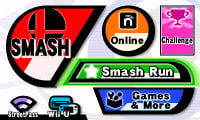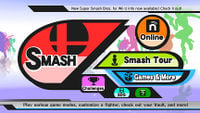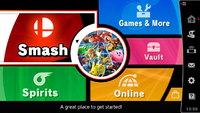| Welcome to SmashWiki! Log in or create an account and join the community, and don't forget to read this first! |
| Notices |
|---|
| The Skill parameter has been removed from Smasher infoboxes, and in its place are the new "Best historical ranking" and "Best tournament result" parameters. SmashWiki needs help adding these new parameters to Smasher infoboxes, refer to the guidelines here for what should be included in these new parameters. |
| When adding results to Smasher pages, include each tournament's entrant number in addition to the player's placement, and use the {{Trn}} template with the matching game specified. Please also fix old results on Smasher pages that do not abide to this standard. Refer to our Smasher article guidelines to see how results tables should be formatted. |
| Check out our project page for ongoing projects that SmashWiki needs help with. |
Mode
- "Solo" redirects here. For the Hero of Dragon Quest IV who is one of Hero's alternate costumes, see Hero.
Modes (sometimes referred to as Menus) are various ways to play Super Smash Bros. games. The list below shows all the modes of each games and compares them.
Comparison[edit]
| Starter | Unlockable | Added via update | As part of another mode | No longer functions |
Notes[edit]
In Super Smash Bros.[edit]
1P Mode[edit]
VS Mode[edit]
- Handicap
- Team Attack
- Stage Select
- Damage
- Item Switch[1]
Option[edit]
Data[edit]
In Super Smash Bros. Melee[edit]
The * indicates that this mode must be unlocked.
1-P Mode[edit]
- Regular Match
Vs. Mode[edit]
Trophies[edit]
Options[edit]
Data[edit]
- Snapshots
- Archives (NTSC)
- Sound Test*
- How to Play (PAL)
- Melee Records
Only accessible via hacking[edit]
In Super Smash Bros. Brawl[edit]
The * indicates that this mode must be unlocked. Any mode that utilizes online functionality is no longer officially supported.
Solo[edit]
Group[edit]
Nintendo Wi-Fi[edit]
Options[edit]
Vault[edit]
Data[edit]
- Movies
- Records
- Group Records
- Brawl Records
- Notices
- Sound Test
In Super Smash Bros. 4[edit]
Any mode that utilizes online functionality is no longer officially supported.
Smash[edit]
 Smash Run[edit]
Smash Run[edit]
 Smash Tour[edit]
Smash Tour[edit]
Games & More[edit]
- Classic Mode
- All-Star Mode
- Stadium
- Training Mode
 Events
Events Special Orders
Special Orders
- Custom
 Stage Builder
Stage Builder- amiibo (
 added in version 1.0.5 on New 3DS and version 1.0.8 on 3DS /
added in version 1.0.5 on New 3DS and version 1.0.8 on 3DS /  available at release)
available at release) - Vault
- Options
Online[edit]
- With Anyone
- With Friends
 Tourney (added in version 1.1.0)
Tourney (added in version 1.1.0)- Conquest (
 added in version 1.0.1 /
added in version 1.0.1 /  available at release)
available at release) - Spectate
- Share (
 added in version 1.0.5 /
added in version 1.0.5 /  available at release)
available at release)
Other modes[edit]
- Challenges
 StreetSmash
StreetSmash Wii U connect /
Wii U connect /  3DS connect
3DS connect
In Super Smash Bros. Ultimate[edit]
Smash[edit]
8-Player Smash is available as part of the regular Smash mode, and so it does not occupy a separate menu item as it did in Super Smash Bros. for Wii U.
Games & More[edit]
- Classic Mode
- Training
- Mob Smash
- Home-Run Contest (Added in version 5.0.0)
- Mii Fighters
- amiibo
- Stage Builder (Added in version 3.0.0)
- Challenger's Approach (only if there are fighters that must be unlocked and haven't been)
- VR (Added in version 3.1.0)
Online[edit]
- Smash
- Online Tourney (Added in version 4.0.0)
- Spectate
- Shared Content (Added in version 3.0.0)
Vault[edit]
- Sounds
- Replays
- Video Editor (Added in version 3.0.0)
- Records
- Challenges
- Tips
- Movies
- Shop
Spirits[edit]
- Adventure Mode
- Spirit Board
- Collection
- Rematch (Added in version 8.0.0)
- DLC Spirits (Added in version 3.0.0)
Dashboard[edit]
- Return to Top Menu
- Collection
- Local Wireless
- News
- Options
- Help
Other[edit]
- Sephiroth Challenge (Added in version 10.0.0) (Limited-time: removed in version 10.1.0)
In competitive play[edit]
Many modes across the Smash series have developed their own competitive communities over the years. The most popular mode by a wide margin is the Vs. Mode of each game, which forms the basis for each game's tournament scene. While the exact rules and structure vary between games and region, the basic outline involves at least two players picking a character and a legal stage and playing until one is declared the winner. 1v1 games (often referred to as "singles") are the most popular format, but other formats such as 2v2 (often referred to as "doubles"), Squad Strike, and occasionally free for all and Smashdown matches also take place. Games involving Special Smash have also developed a niche competitive scene, with specific rules and conditions gaining popularity in side events.
Single player modes have also developed their own unique communities. Most modes involve the achieving or breaking of some kind of record. Since players do not directly compete with each other in this format, a leaderboard system is often used to track these records. Players will submit their gameplay to the leaderboard for review, where it will be determined if the gameplay is both legitimate and meets all established standards. If it passes, it goes onto the leaderboard. Games that track a high score like Home-Run Contest and Multi-Man Smash have active communities frequently developing new techniques and strategies to achieve the highest possible score. Modes with a clear end point like All-Star Mode, Classic Mode, Target Smash and Events also have communities that also develop new techniques and strategies to complete the modes in the least possible amount of time, often dubbed a speedrun.
Modes that can be played online have mostly the same rules as offline, though some differ slightly to account for the different environment. There are often penalties put in place in the event of internet connectivity issues, with contingency plans set up in the case of major catastrophes. Some communities require certain modes to be played offline with official hardware, as playing online often means using emulators and unverified hardware, which brings the possibility of inconsistent gameplay and cheating.
Trivia[edit]
- In the Japanese version of Melee, the Main Menu is instead named Top Menu. Additionally, it was originally going to be named Top Menu in English as well, but the final version of the game reverts the name back to Main Menu.
- Ultimate uses the name Top Menu in English, under the Dashboard's "Back to Top Menu" option.
- Masahiro Sakurai stated in a YouTube video that he created Break the Targets! as an indirect tutorial to play the characters in lieu of a proper tutorial mode. He also stated in the video that he wanted to include a full tutorial mode into Ultimate, but the concept had to be scrapped due to time constraints, a situation he regrets to this day.[3]
References[edit]
- ^ Jump up to: a b Must first be unlocked
- ^ European version only
- ^ Teaching Players How to Play [Design Specifics]
Notes[edit]
| show Super Smash Bros. menu items |
|---|
| show Super Smash Bros. Melee menu items |
|---|
| show Super Smash Bros. Brawl menu items |
|---|
| show Super Smash Bros. for Nintendo 3DS menu items |
|---|
| show Super Smash Bros. for Wii U menu items |
|---|
| show Super Smash Bros. Ultimate menu items |
|---|
